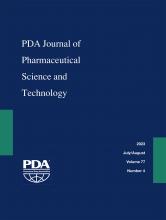Abstract
A Contamination Control Strategy (CCS) is a document that focuses on how to prevent contaminations with microorganisms, particles, and pyrogens within sterile and/or aseptic and preferably also in nonsterile manufacturing facilities. This document determines to what extent measures and controls in place are efficient in preventing contamination. In order to efficiently evaluate and control all potential hazards associated with sources of contamination within a CCS, the Hazard Analysis Critical Control Point (HACCP) methodology could be a useful tool to monitor all Critical Control Points (CCPs) related to various sources of contamination. This article describes a way to set up the CCS within a pharmaceutical sterile and aseptic manufacturing facility (GE HealthCare Pharmaceutical Diagnostics) by applying the HACCP methodology. In 2021, a global CCS procedure and a general HACCP template became effective for the GE HealthCare Pharmaceutical Diagnostics sites having sterile and/or aseptic manufacturing processes. This procedure guides the sites through the setup of the CCS by applying the HACCP methodology and helps each site to evaluate whether the CCS is still effective taking all (proactive and retrospective) data following the CCS into account. A summary of setting up a CCS using the HACCP methodology, specifically for the pharmaceutical company GE HealthCare Pharmaceutical Diagnostics Eindhoven site, is provided in this article. Use of the HACCP methodology enables a company to include proactive data within the CCS, making use of all identified sources of contamination, associated hazards, and/or control measures and CCPs. The constructed CCS allows the manufacturer to identify whether all included sources of contamination are under control and, if not, which mitigatory actions need to be performed. All current states are reflected by a traffic light color to reflect the level of residual risk, thereby providing a simple and clear visual representation of the current contamination control and microbial state of the manufacturing site.
- © PDA, Inc. 2023
PDA members receive access to all articles published in the current year and previous volume year. Institutional subscribers received access to all content. Log in below to receive access to this article if you are either of these.
If you are neither or you are a PDA member trying to access an article outside of your membership license, then you must purchase access to this article (below). If you do not have a username or password for JPST, you will be required to create an account prior to purchasing.
Full issue PDFs are for PDA members only.
Note to pda.org users
The PDA and PDA bookstore websites (www.pda.org and www.pda.org/bookstore) are separate websites from the PDA JPST website. When you first join PDA, your initial UserID and Password are sent to HighWirePress to create your PDA JPST account. Subsequent UserrID and Password changes required at the PDA websites will not pass on to PDA JPST and vice versa. If you forget your PDA JPST UserID and/or Password, you can request help to retrieve UserID and reset Password below.






